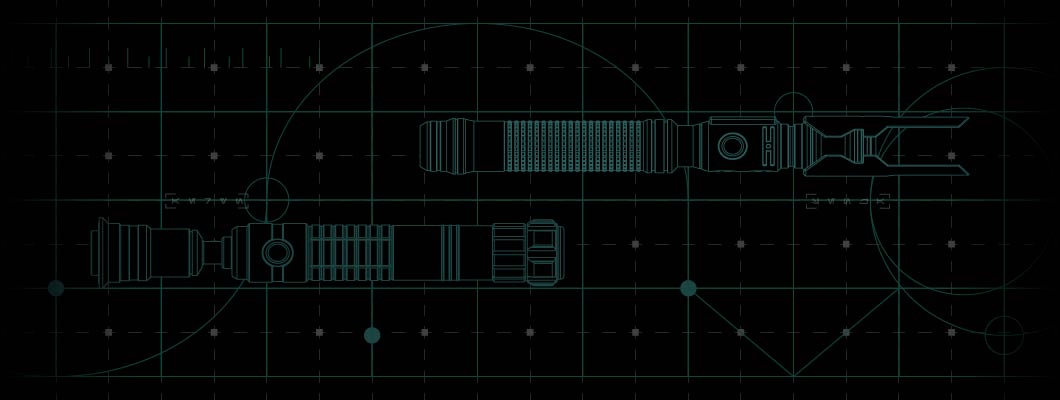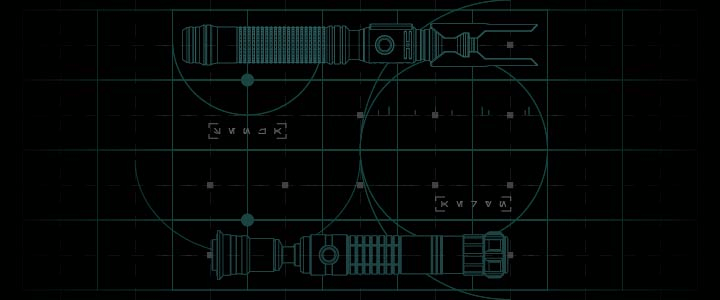


Sabertrio User Guide – Importing and Formatting Music for Your Lightsaber
importing music
IMPORTING MUSIC
Sometimes a duel is only as good as the background music, and you can score your own battles right from a Sabertrio saber hilt. This section covers how to import and properly format music.
Importing Music - Neo CFX Saber
The soundboard of your Neo CFX Saber can only play audio with the following codec:
Format: .wav
Sample Rate: 44100 Hz
Sample Format: 16-bits, mono
Your Neo CFX Saber has two ways of handling tracks: The iSaber
Music Player or played directly from a sound font.
iSaber is essentially a media visualize mode that flickers the
blade in time with the music. The blade color, profile and sound
effects all follow whichever sound font you had selected prior to
entering iSaber.
Tracks inside individual sound fonts act more like background music
for your duels, allowing you to play a track without the flickering
visualizer effect.
iSaber - Importing/Playing Tracks
Importing Tracks
Place your properly formatted .WAV files into the 'tracks' folder,
located in the ROOT directory of your microSD card.
Rename the file so it follows the order/naming structure of the other
audio files. For example, if this is the 7th track, it should be
named 'track7'.
Playing Tracks
Reinsert the microSD card and chassis, turn on your Neo CFX Saber,
and navigate to the Soundbank Selection menu.
To do that, cycle through all sound fonts until you hear the iconic
cantina jingle followed by someone saying “Audio Player”. Hold the
Auxiliary Switch to select it.
You can also view how to navigate there on the 'Saber Operation'
page under the Neo CFX Saber operation flowchart.
View 'Saber Operation' to learn more
The saber will randomly select an audio file from its 'tracks' folder
and immediately start playing it.
A quick double-press of the Activation Switch will play/pause the track.
When the blade is off, press & hold the Activation Switch to shuffle
to the next track.
Sound Fonts - Importing/Playing Tracks
Importing Tracks
Select a sound font and open its folder.
If you don't see a 'tracks' folder, create one.
Place your .WAV audio file(s) into the 'tracks' folder.
Rename the file so it follows the order/naming structure
of the other audio files.
For example, if this is the 7th track, it should be
named 'track7'.
Playing Tracks
To play the track, while using that sound font quickly double-press
the Activation Switch to play/pause the track.
If there are multiple tracks, the saber will select one at random.
You can shuffle to another track by holding down the Activation Switch
while the blade is off.
Formatting Audio
We will be using Audacity in this guide, but so long as the file is
formatted/exported in the same codec any sound/music editor will work.
Download Audacity
Step 1
Import your audio file into Audacity.
One way to do this is by navigating to the toolbar, open the 'File' menu,
then the 'Import' submenu and select 'Audio'. Select your audio file then
click 'Open' to import it.
Step 2
If your track is in stereo (two parallel channels), convert it to mono. With the track selected, navigate to the 'Tracks' menu in the toolbar, then the 'Mix' submenu and select 'Mix Stereo Down to Mono'.
Notice
Connecting a Power Core saber to a stereo speaker system via an aux chip will not allow you to play stereo tracks.Step 3
Open the 'Audio Setup' menu and click 'Audio Settings'.
Under 'Quality', ensure that the 'Project Sample Rate' is set to '44100 Hz'
and the 'Default Sample Format' is '16-bit'. You do not need to change any
other settings in this menu.
Step 4
Double-check that 'Save as type' is set to 'WAV (Microsoft)' and that 'Encoding' is set to 'Sign 16-bit PCM'.
Step 5
The info in the 'Edit Metadata Tags' menu will not affect or be read by the saber.
Click 'OK' to finish.
Checking an Audio File's Format
Open/play your file with VLC Media Player.
Download VLC Media Player
In the toolbar, click on 'View', then 'Playlist'.
Right-click on the file and click 'Information'.
In the 'Media Information' menu that opens, navigate to the 'Codec' tab.
If the displayed sample rate is '44100 Hz' and the bits per sample is
'16', the .WAV file will work with all Sabertrio Saber configurations.



